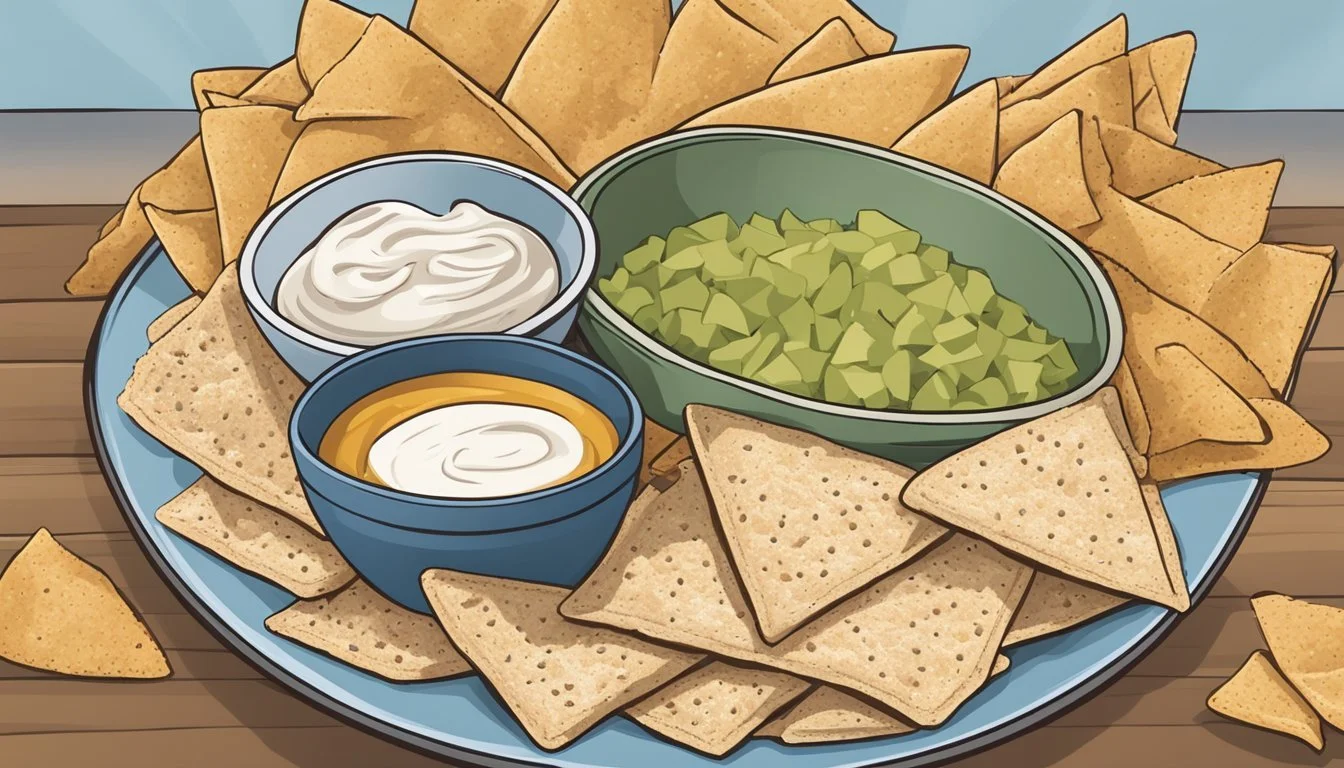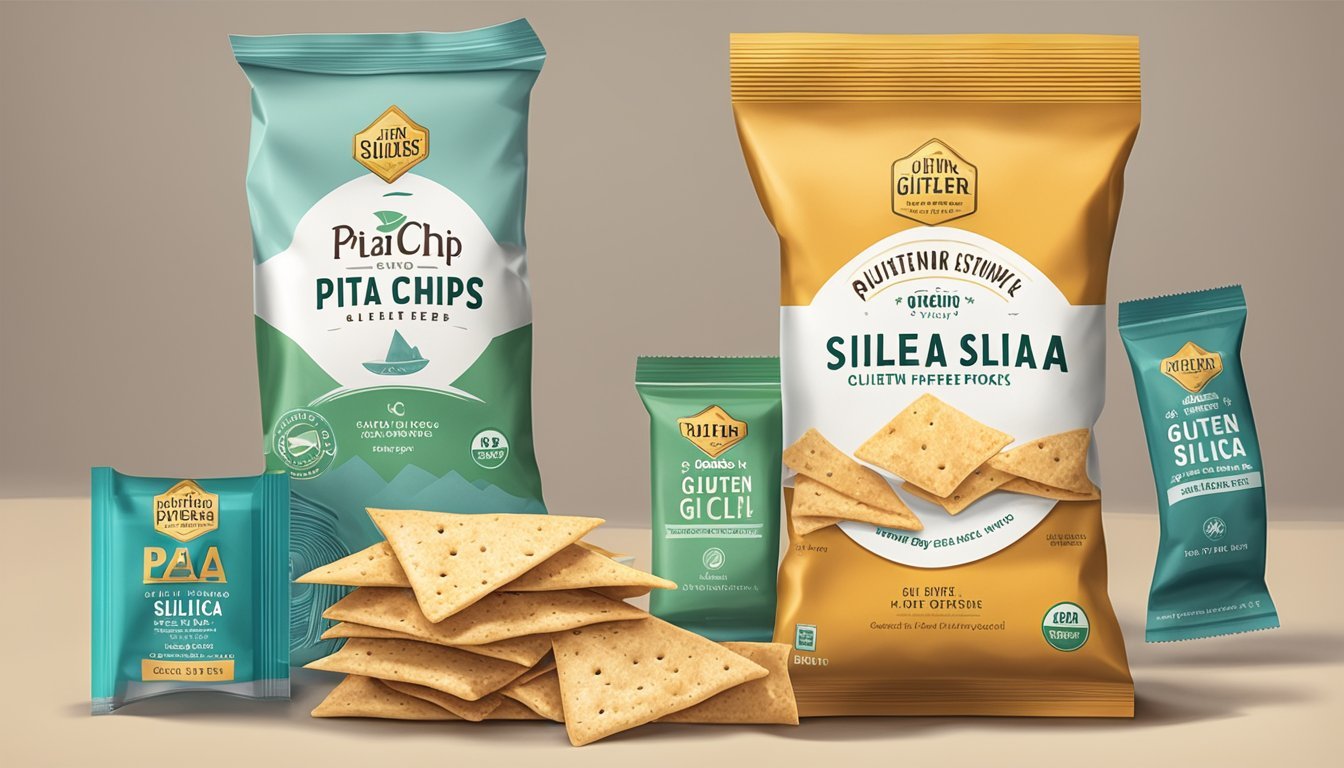Are Pita Chips Gluten-Free?
Understanding Their Ingredients and Celiac Safety
Pita chips have gained popularity as a snack option due to their satisfying crunch and versatility in pairing with dips and spreads. Traditionally, pita bread is made with wheat flour, which contains gluten, a protein that gives dough its elasticity. As such, conventional pita chips are not gluten-free. This poses a challenge for individuals with gluten intolerance or celiac disease, who must avoid gluten to prevent adverse health effects.
In response to the growing demand for gluten-free products, manufacturers have developed gluten-free pita chips. These pita chips are often made with gluten-free flours such as rice flour, tapioca flour, or a blend of various gluten-free grains. The rise in the availability of gluten-free products provides a wider array of snack options for those who follow a gluten-free diet. Gluten-free pita chips can now be found in many grocery stores, and some brands are even certified gluten-free, ensuring they are safe for individuals with sensitivities to gluten.
The texture and taste of gluten-free pita chips can differ from their traditional counterparts, yet they deliver a similar experience that many consumers find satisfactory. The key to achieving a crispy and flavorful chip lies in the combination of the gluten-free dough and the method of preparation, whether baked or air-fried. Seasonings such as sea salt, herbs, and spices are commonly added to enhance the flavor profile of gluten-free pita chips, making them a delightful alternative to those containing gluten.
Understanding Gluten and Its Effects
In this section, readers will gain insights into what gluten is, its impact on health, and the conditions linked with gluten intolerance, such as celiac disease and gluten sensitivity.
What Is Gluten?
Gluten refers to a group of proteins commonly found in wheat, rye, barley, and to a lesser extent, oats. It acts as a binding agent, giving dough its elasticity and allowing bread to rise during baking. Its presence is widespread in various products, extending beyond just bread and bakery items, to include sauces, dressings, and even some cosmetics.
Gluten's Impact on Health
For most people, consuming gluten is perfectly safe. However, for individuals with gluten-related disorders, ingestion can trigger an array of symptoms. Gluten can cause digestive issues, such as bloating, diarrhea, and constipation, as well as systemic symptoms, including headaches, fatigue, and joint pain in sensitive individuals.
Celiac Disease and Gluten Sensitivity
Celiac Disease: An autoimmune disorder where ingestion of gluten leads to damage in the small intestine. It affects about 1% of the population globally. When people with celiac disease consume gluten, their body mounts an immune response that attacks the small intestine. This can result in malabsorption of nutrients and lead to various complications if left untreated.
Gluten Sensitivity: Also known as non-celiac gluten sensitivity, is a condition wherein individuals experience symptoms related to gluten consumption, in the absence of celiac disease or wheat allergy. Symptoms can range from gastrointestinal issues to a feeling of malaise. Unlike celiac disease, non-celiac gluten sensitivity doesn't cause lasting damage to the body's tissues.
Pita Chips Basics
Pita chips are a crunchy snack often enjoyed for their satisfying texture and versatility with dips. This section will explore what constitutes pita chips and the distinctions between regular and gluten-free varieties.
What Are Pita Chips?
Pita chips are made by cutting pita bread into small, triangular pieces and baking them until they are crispy. They are commonly seasoned with various spices and can be served alongside hummus, dips, or eaten alone as a snack.
Regular Pita Bread vs Gluten-Free Pita Bread
Regular pita bread is traditionally made with wheat flour, which contains gluten, a protein that provides elasticity and strength to the dough. In contrast, gluten-free pita bread utilizes flours that do not contain gluten, such as rice flour or chickpea flour. These ingredients allow those with celiac disease or gluten sensitivity to enjoy pita chips without the adverse effects of consuming gluten. Gluten-free pita chips are prepared with similar methods as regular pita chips, ensuring they provide a comparable snacking experience without the presence of gluten.
Making Gluten-Free Pita Chips
For individuals with gluten sensitivities or celiac disease, gluten-free pita chips are a mindful alternative to their wheat-based counterparts. They offer the same satisfying crunch and versatility in flavoring but require specific gluten-free ingredients and preparation methods.
Ingredients for Gluten-Free Pita Chips
Gluten-Free Pita Bread: Typically made with gluten-free flour such as almond, rice, or a blend of gluten-free flours to ensure no wheat is used.
Oil: Olive oil or avocado oil for a crisp texture.
Seasonings: A mix of sea salt and spices like Za'atar for flavor. Additional spices or herbs can be added to taste.
Creating Your Own Gluten-Free Pita Chips at Home
One can begin by preheating their oven to 400°F (200°C) or preparing their air fryer to 360°F. Gluten-free pita bread should be cut into triangles and arranged on a baking sheet or in the air fryer basket in a single layer, ensuring they are not overlapping. A generous brushing or spraying of oil, followed by an even sprinkling of sea salt and chosen spices, is crucial for that desired crispiness and flavor.
Gluten-Free Pita Chips Recipes
Oven-Baked Pita Chips: After prepping pitas with oil and spices, bake them in the preheated oven for about 10-12 minutes or until golden and crispy, turning halfway through.
Air Fryer Pita Chips: For those who prefer using an air fryer, cook the seasoned pita pieces at 360°F for about 5-8 minutes, checking frequently until they are crisp to satisfaction.
By adhering to these guidelines, one can create delicious and safe gluten-free pita chips in the comfort of their own kitchen.
Health and Nutrition
In assessing whether pita chips are gluten-free, it's essential to consider the product's caloric and nutrient content and the accuracy of gluten-free certifications on labels.
Caloric and Nutrient Content
Analyzing the nutritional profile of pita chips, one typically finds that a serving size (which may vary by brand) generally contains a notable amount of calories and carbohydrates. For instance, one ounce of salted pita chips typically contains around 130 calories, 19 grams of carbohydrates, and a smaller amount of protein, roughly 3.3 grams. Pita chips also contain fats — an average of 4.3 grams per serving, with some being saturated fat. They can also contain a modest amount of dietary fiber, approximately 1.1 grams per serving. The sodium content is worth noting, as pita chips can be high in sodium, making it important for consumers to monitor intake if they are managing sodium consumption for health reasons.
Understanding Labels: Certified Gluten-Free
When looking for gluten-free pita chips, it's crucial to search for labels that specifically mark the product as certified gluten-free. This certification ensures that the chips have been produced in a manner that avoids cross-contamination with gluten-containing grains, a critical consideration for individuals with celiac disease or gluten intolerance. Consumers should scrutinize the packaging for a seal from a recognized gluten-free certification organization. Brands that offer certified gluten-free products typically make this a prominent feature on their packaging. However, due to production practices, some pita chip manufacturers may produce both gluten-free and gluten-containing products, potentially leading to cross-contamination if strict protocols are not followed. Therefore, consumers need to be diligent in verifying the certifications and the reliability of the brand when selecting gluten-free pita chips.
Selecting Gluten-Free Pita Chips
Selecting the right gluten-free pita chips involves understanding the ingredients that make them suitable for a gluten-free diet and ensuring there is no cross-contamination with gluten-containing products during manufacturing.
Ingredients to Look For
When seeking gluten-free pita chips, one must scrutinize the ingredient label for gluten-free alternatives to wheat flour. Here are some key ingredients that are typically used in gluten-free pita chips:
Tapioca Starch: Derived from cassava root, this starch is a common gluten-free ingredient that provides a desirable texture.
Rice Flour: A staple in gluten-free products, rice flour serves as a wheat flour substitute.
Potato Starch: Like tapioca, potato starch adds structure to gluten-free pita chips without any gluten content.
Chickpea Flour: High in protein, chickpea flour is an excellent binding agent in gluten-free recipes.
Xanthan Gum: A thickening agent, xanthan gum helps emulate the chewiness that gluten typically provides.
Seeds (Optional): Various seeds such as sesame or sunflower can add flavor and nutritional value to gluten-free pita chips.
Note: Always look for a certified gluten-free label to ensure the product meets stringent gluten-free standards.
Avoiding Cross-Contamination
The absence of gluten-containing ingredients is not sufficient if the pita chips are produced in a facility that also handles wheat, barley, or rye. Cross-contamination can render gluten-free pita chips unsafe for those with celiac disease or gluten sensitivity. To avoid this:
Verify dedicated gluten-free production lines or facilities are used, which is often mentioned on the packaging.
Look for certification seals from recognized gluten-free organizations, assuring the product has undergone strict testing for gluten presence.
By prioritizing ingredients that align with a gluten-free diet and ensuring manufacturing practices are designed to prevent cross-contamination, consumers can confidently enjoy gluten-free pita chips without compromising their health.
Serving and Pairing Ideas for Pita Chips
When considering gluten-free pita chips, they present a satisfying crunch and a perfect canvas for a variety of dips and appetizers. They are not only a fantastic snack on their own but also offer versatility in pairing options.
Dip Pairings for Gluten-Free Pita Chips
Gluten-free pita chips complement a range of dips, enhancing their flavors and textures. Two popular choices are:
Hummus: A classic Middle Eastern dip, hummus pairs impeccably with the crisp texture of pita chips. It's creamy, rich in protein, and comes in various flavors such as roasted red pepper or garlic.
Tzatziki: This Greek dip, made from yogurt, cucumber, and garlic, offers a refreshing contrast with its cool and tangy profile, which balances the savory notes of the chips.
Other delectable dips include:
Baba Ganoush: An eggplant-based spread with a smoky flavor.
Salsa: For those who prefer a bit of heat and the freshness of tomatoes.
Guacamole: A creamy avocado-based dip that adds a burst of color and a buttery taste.
Versatility of Gluten-Free Pita Chips
As an appetizer, gluten-free pita chips are incredibly versatile. They can be enjoyed:
In salty or sweet applications, seasoned with spices or drizzled with honey.
As a crunchy element in salads or soups, adding texture to each bite.
Alongside cheese platters, pairing well with both soft and hard cheeses.
Their robust structure ensures they hold up well when scooping generous amounts of dip without breaking, providing a reliable and enjoyable eating experience.
Storage and Preservation
To maintain the quality and taste of gluten-free pita chips, proper storage methods are essential. These chips are susceptible to moisture and can become stale if not stored correctly.
Keeping Gluten-Free Pita Chips Fresh
After opening a bag of gluten-free pita chips, one should transfer them to an airtight container to preserve their crispness. The key is to minimize the chips' exposure to air and humidity. An airtight seal prevents moisture from softening the chips, which would otherwise compromise their texture and flavor. If the original packaging is resealable and can provide an airtight barrier, it may be adequate for short-term storage.
Can You Freeze Gluten-Free Pita Chips?
Freezing is a viable option for extending the shelf life of gluten-free pita chips beyond what room temperature storage can offer. To freeze pita chips, they need to be placed in a freezer-safe airtight container or a heavy-duty freezer bag to avoid freezer burn. When one wants to consume the chips, they should be thawed at room temperature before opening the container to prevent condensation from making the chips soggy. While freezing may alter the texture slightly, it's an effective way to preserve the chips for longer periods.
Allergen Considerations
When assessing the allergen content of pita chips, it is crucial to recognize the primary allergens present which includes gluten, soy, and various seeds and nuts. Consumers should distinguish between gluten content and other potential allergens to make informed dietary choices.
Identifying Other Common Allergens
Besides gluten, pita chips may contain other common allergens like soy, seeds, and nuts. Soy is often used in the form of soybean oil or soy lecithin, which are common in processed foods. Additionally, seeds such as sesame or amaranth can be present either as main ingredients or traces due to cross-contamination. It is essential for consumers to read labels carefully and check for these allergens, especially when the pita chips are produced in facilities that also process these items.
Gluten-Free and Vegan: Are They the Same?
The terms gluten-free and vegan often appear together but they refer to different dietary restrictions. Gluten-free products exclude gluten, a protein found in wheat, barley, and rye. Vegan products, on the other hand, exclude all animal-derived ingredients. While a vegan product may naturally be free of certain allergens like dairy and eggs, this does not automatically make it gluten-free unless specified. Pita chips that are labeled gluten-free are safe for individuals with gluten intolerance or celiac disease, but may still contain animal-derived ingredients unless they are also explicitly labeled as vegan.
Advanced Baking Tips
When creating gluten-free pita chips, achieving the ideal texture and flavor is paramount. Through precise baking techniques and the use of diverse seasonings, one can master the craft of producing pita chips that are both delicious and tailored to specific taste preferences.
Achieving the Perfect Crispness
The key to crispy and extra crispy pita chips lies in the control of oven temperature and baking time. One should preheat the oven to 400°F (200°C) and bake the pita chips on the center rack. Initially, bake for about 8 minutes, then flip each pita chip and continue to bake for an additional 6 to 7 minutes. This results in a golden brown crispness. The thickness of the pita also affects the baking time--thinner pieces will require a shorter baking duration to avoid burning.
Seasoning and Flavor Variations
Za’atar Seasoning: A blend of thyme, oregano, sesame seeds, and sumac, za'atar brings a Middle Eastern flair to the chips. One can mix these ingredients in a bowl and coat each piece of pita before baking for a robust flavor.
Garlic and Herb: Combining garlic powder with dried herbs like oregano offers a classic taste. Lightly sprinkling the mixture over the pita chips before baking enhances their savory notes.
For a personalized touch, one may experiment with other flavors and spices, bearing in mind that a uniform distribution of seasoning ensures a consistent taste in every bite.
Adapting Traditional Pita Recipes
When adapting traditional pita recipes to be gluten-free, the key is to replace wheat flour with gluten-free alternatives that still allow the dough to reach a consistency that's similar to the original. These adaptations ensure individuals with gluten sensitivities can still enjoy pita chips.
Gluten-Free Alternatives for Traditional Pita Bread
Traditional pita bread relies on wheat flour which contains gluten, a protein that gives the dough its elasticity. For a gluten-free pita, alternative flours must be used. Here are some common gluten-free flour options:
Chickpea Flour: High in protein and fiber, chickpea flour brings a nutty taste and a hearty texture.
Rice Flour: Usually made from white or brown rice, this flour offers a light and mild flavor.
Corn Flour: This can be used to create a sweet and tender crumb in gluten-free pita.
The blending of these flours can achieve a balance of flavor and texture while mimicking the properties that gluten imparts to traditional pita dough. Yeast can still be used to leaven the gluten-free pita bread, and water remains a staple ingredient for creating the dough.
Creative Uses for Gluten-Free Pita Chips
Converted into chips, gluten-free pita bread becomes a versatile snack. Gluten-Free Pita Chips are not only an option for those with dietary restrictions but also a canvas for various seasonings and dips. Here are a few suggestions:
Season with sea salt and Za'atar spice for a Middle Eastern twist.
Serve with hummus or a bean dip to complement the nutty flavors of chickpea flour-based pita.
Toasted and crushed, turn them into a crunchy flatbread topping for salads and soups.
By maintaining traditional flavors and textures, gluten-free adaptations of pita recipes allow greater inclusivity in culinary traditions.








